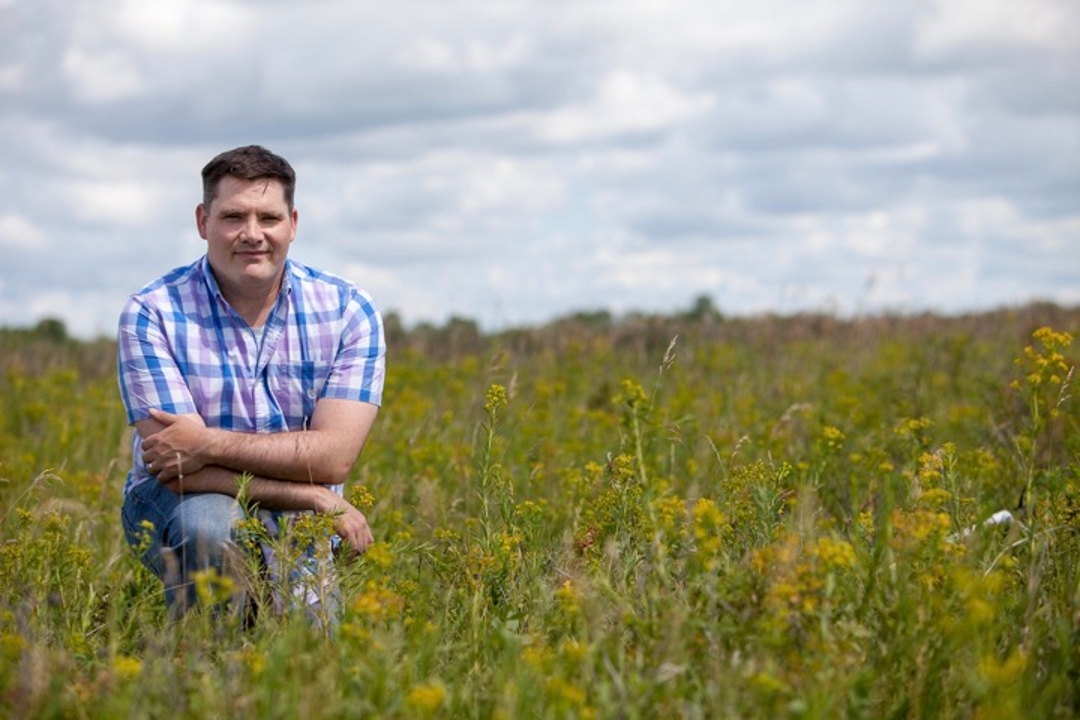
Striking at the roots of leafy spurge
Researchers look to prevent the noxious weed.
By Jeff MelchiorIf leafy spurge isn’t the biggest weed-related threat to rangeland cattle grazing operations in Saskatchewan, it’s almost certainly up there. Not only will cattle not eat it, but it can cause them bodily harm when they do. The result is whole tracts of valuable grazing land being taken over by the noxious weed.
Making matters worse is the fact that it takes more than herbicide to combat leafy spurge. The real battleground against leafy spurge is underground, where its roots can extend as much as 30 feet. Estimates of the total cost to producers vary but are universally high.
A plant sciences researcher with the College of Agriculture and Bioresources at the University of Saskatchewan (USask) has identified some practices which may strike leafy spurge at its roots. Dr. Jon Bennett (PhD) is finishing a project that studied the possibility of using the combination of an herbicide and select fungicide to suppress the weed.
“The takeaway is that Senator fungicide can reduce the abundance of spurge,” said Bennett. “It seems to increase the abundance of grass and it also might allow the recovery of the native grass species.”
“We don’t have the protocols set up to the point where we could recommend that somebody use it on their own land for this purpose, but we do think it’s promising.”
Leafy spurge is a perennial weed which contains a milky substance in its sap that can be harmful to cattle. And because it is easily spread by farm equipment, it’s on the move.
“It's really expanding in Saskatchewan and the Canadian Prairies in general. All of our climate models suggest it will become more and more abundant up here, while it kind of retracts in the southern part of the range in the U.S.”
Leafy spurge has a partner in crime: mycorrhizal fungi which live in the plant and fuel its growth through a symbiotic relationship with the weed. Bennett’s goal was to attack the underground fungi with Senator (a broad spectrum systemic fungicide with the active ingredient thiophanate-methyl) while simultaneously using 2,4-D herbicide to kill leafy spurge above ground.
“The fungicide reduced the abundance of leafy spurge about 30 per cent on average over the course of the year-and-a-half we studied it, a little bit less than the 2,4-D herbicide we used as the top growth suppression of the spurge,” he said. “Between the two, the spurge was reduced by about 65 to 70 per cent.”
Bennett was surprised to find that the fungicide appeared to facilitate desirable plant growth.
“One of the things that happens when you use an herbicide is you lose a lot of plant species so you lose biodiversity,” he said. “One of the things I found interesting is that the fungicide prevented a little bit of that species loss or at least allowed some of those native plant species to either recover more quickly or just persist within those systems.”
More research is still needed to discover the best time to apply the herbicide/fungicide combination, said Bennett.
“We need to find the optimum time for disrupting that transfer between the plant and its fungal symbiont. What’s going to have the best effect in terms of reducing the plant’s growth ability?”
And then there’s the question of whether an herbicide is effective on leafy spurge at a broad scale due to the costs involved.
“We have infested pastures here in the province that are 16,000 acres. You’re not going to go out and spray 16,000 acres worth of herbicide that kills all broadleaf plants. That would be pretty disastrous for the system and very expensive.”
Most herbicides are incapable of suppressing leafy spurge at its roots. However, Navius (active ingredient: aminocyclopyrachlor) is a relatively new product that has been recommended by the Province of Saskatchewan for use on leafy spurge.
“One of the benefits of Navius is that it has a soil residual, meaning that it doesn’t readily degrade,” Bennett said. “It can sit in the soil for two to three years and kill any regrowing plants. After it does degrade, however, we see the plants regrow at that point. The drawback to Navius is that it is very expensive relative to a lot of other herbicides.”
Aside from minimizing costs by finding efficiencies, there are still some questions around the use of Navius. Bennett and USask soil science researcher Dr. Bobbi Helgason (PhD) recently launched a project to answer some of them. The project is being run by student Erin Malis.
“Does a single herbicide application provide long-lasting control of leafy spurge? Can you get away with just one or do you need to come back later? How does it affect other plants? Can we minimize non-target effects?”
The broader aim of the study is to find out how Navius affects the soil.
“Grasslands are incredible carbon stores and a lot of—if not almost all—of the carbon storage systems are below ground. If we change, for example, how carbon is processed in these systems, are we losing more carbon to the atmosphere than we would otherwise?” said Bennett.
“Maybe we need to consider what the minimum application (of Navius) would need to be to keep the leafy spurge under control so it’s not affecting the use of the land while still being able to maintain some of these other important functions.”
Agknowledge, December 2020

